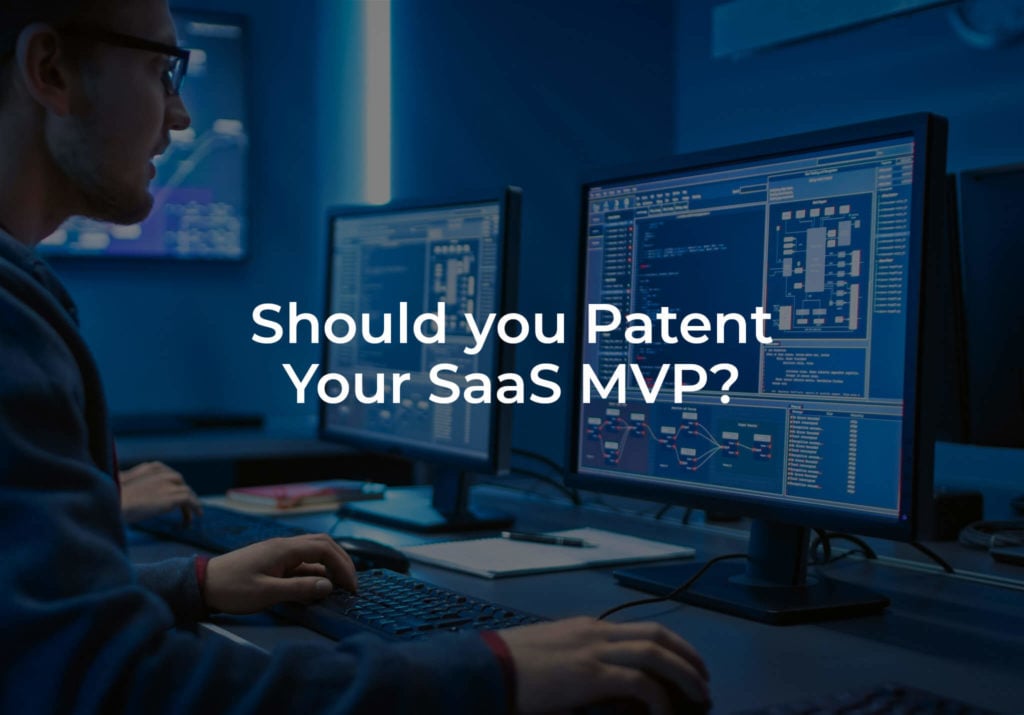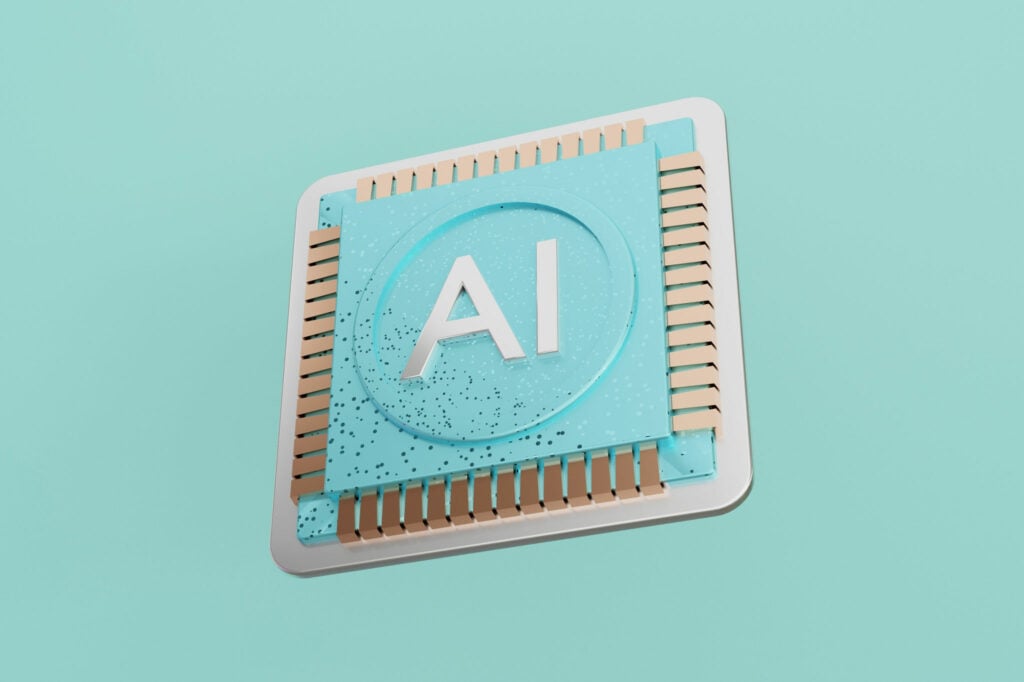Short Answer: Yes.
And if you already created your MVP (Minimum Viable Product), you should probably hurry.
Click here to find strategies for protecting your SaaS business intellectual property.
Not sure about patents, SaaS, or MVPs? This article explains why most businesses should patent their SaaS MVP as soon as possible, even before starting research and/or development. But first, let us explain what a SaaS MVP is so that you can find out whether your SaaS MVP has patentable features.
Read this article to learn more about what makes an idea or invention patent eligible.
What is a SaaS MVP?
To understand what a SaaS MVP is we need to differentiate between a SaaS and an MVP.
SaaS stands for “Software as a Service.” As discussed in our SaaS Agreements: Developing A Strong Legal Foundation article:
SaaS typically consists of software applications that are made available over the internet and are tied to a subscription fee, which may be tiered based on the end user’s desired level of service. Often these services are managed by a third party.
Instead of determining whether you have the right type of computer and software, installing the software on your computer, and keeping the software updated, SaaS allows you to access applications over the internet using a web browser.
An MVP, or Minimum Viable Product, is a version of your product that has implemented the minimum number of features in order to go to market. In other words, an MVP is a new product offering in a reduced or simplified form.
If we take a SaaS and add MVP, we get a SaaS MVP, a version of a new SaaS with a minimal number of features (whether those features are services, functions, compatibilities, integrations, automations, efficiencies, redundancies, customizations, etc.) that is ready for the market.
Advisors, entrepreneurs, and business consultants will typically say that once you identify the features of your SaaS MVP, you should (1) develop a landing page conveying your product idea, (2) present the problem and the solution that your SaaS MVP delivers, and (3) keep the solution simple and deliver it manually. However, at this point you may not have not developed your SaaS MVP. This is the perfect moment to speak with an intellectual property attorney about the features of your SaaS MVP that you want to protect.
Determining If Your SaaS MVP Has Patentable Features
A straightforward way to determine whether your SaaS MVP has patentable features is to ask yourself a series of questions:
Does your SaaS MVP have proprietary key features?
Your SaaS MVP is proprietary if you intend to own the software behind the SaaS MVP or the processes implemented by your SaaS MVP.
Does your SaaS MVP have a unique process?
Generally, you will rely on your experience and industry knowledge to determine whether competitors have developed also developed any SaaS with similar processes to your SaaS MVP. Part of the reason it is important to plan and prepare early in the patenting process is that the United States has a first-to-file patent system that gives priority to whomever files a patent application first. Another reason is that if you make a disclosure of your invention or offer it for sale you might have inadvertently and unknowingly triggered a countdown to a filing deadline for a patent application. Under patent law, the timing of your filing and disclosures as well as those of others, along with a number of other circumstances, may affect the legal determination of whether your SaaS MVP is unique.
Does your SaaS MVP have a unique UI?
The visual aspects of a unique user interface (UI), also referred to as a graphical user interface (GUI), might be patentable under a design patent.
There is no guarantee that the features of your SaaS MVP will be patentable. Even when you have identified patentable features, it is possible that others have published identical or similar ideas or inventions, which could create barriers to obtaining a patent. Patent applications are examined by Patent Examiners at the United States Patent and Trademark Office (USPTO) who determine whether the patent application is allowable for the granting of a patent. Inventors and businesses often execute prior art searches to avoid filing patent applications with low chances of success., since the patent application process can become expensive if close prior art is.
Evaluating The Competitive Landscape – Prior Art Searches
A prior art search can help you perfect your SaaS MVP, improve your patent application, and learn about technologies that competitors are using. There are different types of prior art searches including novelty and landscape searches. A novelty search looks for prior art that might be a barrier to obtaining a patent. A landscape search looks for innovations that competitors are using, technology areas they are exploring, and opportunity areas where technology has yet to be further developed. While the purpose of each type of search differs, the results can often overlap. Novelty searches, which are common before the drafting of a patent application, can reveal what competitors are developing or trying to protect with their own patent filings. Businesses can acquire insight into competitors’ strategies and knowledge of the current state of their technologies, even when the purpose of their novelty prior art search is not to explore the current patent landscape, but to discover potential impediments to their patent application.
Protecting Your Key Features While Fundraising
Often, creating a SaaS MVP and developing other areas of a business occur in parallel. Building a business will inevitably expose your products or services to others. Patent law often requires timely filing of patent applications and other documents. Engaging in business often includes actions, decisions, and choices that trigger deadlines to file patent documents. This is of particular concern when fundraising because inventors and entrepreneurs often find themselves sharing information about their ideas and inventions before taking measures to protect their intellectual property. As stated above, there is no guarantee that the features of your SaaS MVP will be patentable. Filing a provisional patent application can preserve your patent rights while you develop your SaaS MVP or while you raise funds for your business. However, preparation is the best way to protect your software and technologies.
To be prepared for business and protect your SaaS MVP, you need to know what your intellectual property is and why it is important. If you do not know your intellectual property, you will not be able to identify it and protect it. You also need to understand the legal tools that are available to help protect your SaaS MVP, such as patents, trademarks, copyrights, trade secrets, non-disclosure agreements, and technology transfer agreements. Having an intellectual property attorney on your side and knowing when to consult them can make the difference between launching a successful venture and losing your intellectual property to competitors.
Before your next meeting, presentation, or pitch, make sure you are protected and consider consulting with an experienced software patent attorney.
Understanding The Patent Application Process for Your SaaS MVP
You can take steps to reduce costs and accelerate protection for your SaaS MVP by learning the patent application process. The USPTO offers information on the patent process and how to prepare for filing a patent application. Generally, the path from conceptualizing an idea for a SaaS MVP to the filing of a patent application involves the following steps:
Identifying the type of intellectual property that you need for your SaaS MVP
Most businesses need more than one type of intellectual property protection and those needs can change depending on their products, services, and business strategy. You may need a trademark for your brand, copyright for your website, technology transfer language in employment contracts for your employees and independent contractors, and patents to protect the technical features of your SaaS MVP. Your SaaS MVP and your website may require design patents or utility patents. Identifying these needs is the first step towards protection.
Determine if your SaaS MVP is patentable
As discussed above, you need to know whether your SaaS MVP has patentable features.
Determine the type of patent for your SaaS MVP
Once you determine that your SaaS MVP has patentable features, those features will reveal the type (or types) of patent protection you should seek. If the features include useful and novel processes, functions, methods, solutions, structures, and/or technologies, you need a utility patent application. If time is of the essence, if you have filing deadlines due to past public disclosures or planned future disclosures, or if you are still developing your SaaS MVP, you should consider a provisional patent application. If ornamental aspects or the appearance of your SaaS MVP are unique, you should consider a design patent.
Draft and file your patent application
In the 1892 decision in the case Topliff v. Topliff, 145 U.S. 156, 12 S.Ct. 825, 36 L.Ed. 658, the U.S. Supreme Court described the practice of patent drafting as follows:
The specification and claims of a patent, particularly if the invention be at all complicated, constitute one of the most difficult legal instruments to draw with accuracy, and in view of the fact that valuable inventions are often placed in the hands of inexperienced persons to prepare such specifications and claims, it is no matter of surprise that the latter frequently fail to describe with requisite certainty the exact invention of the patentee, and err either in claiming that which the patentee had not in fact invented, or in omitting some element which was a valuable or essential part of his actual invention.
Inventions, technologies, and the law of patents have grown more complex since 1892.
Patent applications are not technical documents. Instead, they are legal documents with scientific or technological information included. Language that is included in a patent application and may appear innocuous could delay or even destroy your chances of obtaining a patent. You could read the voluminous USPTO Manual of Patent Examining Procedure to learn how to prepare a patent application. However, procuring the assistance of a registered patent attorney is likely to save you time and avoid costly mistakes.
Prepare for a potential office action
The goal of every patent application is to obtain the broadest protection possible. However, part of the job of USPTO Patent Examiners is to ensure that patents granted by the USPTO do not cover technology that is already in the public domain or that was already patented. A back and forth process between your patent attorney and the USPTO to determine the scope of patent protection for your invention frequently begins with an opening salvo of broad claims in your patent application, since your objective is always to acquire the broadest claims possible. It is normal and even expected to receive an initial rejection (formally, a non-final Office Action) of your patent application’s initial claims. In addition to the costs of preparing and filing a patent application, talk with your attorney about how to approach any Office action and budget for possible costs.
Consult With an Experienced SaaS Patent Attorney
The Rapacke Law Group is an intellectual property and business law firm built for the speed of startups, with patent attorneys experienced in software and SaaS technologies. No hourly building, no charges for calls or emails. We offer startup legal services for a transparent flat fee. Our experience ranges from initial business formation and planning to the final liquidity event. Our startup lawyers are involved with fast-moving entrepreneurial companies seeking legal counsel in IP asset protection, company formation agreements, liability, equity issuance, venture financing, and infringement resolution and litigation. Take our Intelligent IP Quiz to determine the best type of protection you need for your business or contact us to schedule a free consultation with one of our experienced attorneys.





